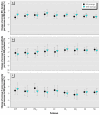Repolarization changes induced by air pollution in ischemic heart disease patients
- PMID: 15811835
- PMCID: PMC1278484
- DOI: 10.1289/ehp.7579
Repolarization changes induced by air pollution in ischemic heart disease patients
Abstract
Epidemiologic studies report associations between particulate air pollution and cardiovascular morbidity and mortality, but the underlying pathophysiologic mechanisms are still unclear. We tested the hypothesis that patients with preexisting coronary heart disease experience changes in the repolarization parameters in association with rising concentrations of air pollution. A prospective panel study was conducted in Erfurt, East Germany, with 12 repeated electrocardiogram (ECG) recordings in 56 males with ischemic heart disease. Hourly particulate and gaseous air pollution and meteorologic data were acquired. The following ECG parameters reflecting myocardial substrate and vulnerability were measured: QT duration, T-wave amplitude, T-wave complexity, and variability of T-wave complexity. Fixed effect regression analysis was used adjusting for subject, trend, weekday, and meteorology. The analysis showed a significant increase in QT duration in response to exposure to organic carbon; a significant decrease in T-wave amplitude with exposure to ultrafine, accumulation mode, and PM2.5 particles (particles < 2.5 microm in aerodynamic diameter); and a corresponding significant increase of T-wave complexity in association with PM2.5 particles for the 24 hr before ECG recordings. Variability of T-wave complexity showed a significant increase with organic and elemental carbon in the same time interval. This study provides evidence suggesting an immediate effect of air pollution on repolarization duration, morphology, and variability representing myocardial substrate and vulnerability, key factors in the mechanisms of cardiac death.
Figures



References
-
- Atiga WL, Calkins H, Lawrence JH, Tomaselli GF, Smith JM, Berger RD. Beat-to-beat repolarization lability identifies patients at risk for sudden cardiac death. J Cardiovasc Electrophysiol. 1998;9:899–908. - PubMed
-
- Bednar MM, Harrigan EP, Anziano RJ, Camm AJ, Ruskin JN. The QT interval. Prog Cardiovasc Dis. 2001;43(5 suppl 1):1–45. - PubMed
-
- Berger RD, Kasper EK, Baughman KL, Marban E, Calkins H, Tomaselli GF. Beat-to-beat QT interval variability. Circulation. 1997;96:1557–1565. - PubMed
-
- Brook RD, Franklin B, Cascio WE, Hong Y, Howard G, Lipsett M, et al. Air pollution and cardiovascular disease. Circulation. 2004;109:2655–2671. - PubMed
-
- Campen MJ, Nolan JP, Schladweiler MC, Kodavanti UP, Costa DL, Watkinson WP. Cardiac and thermoregulatory effects of instilled particulate matter-associated transition metals in healthy and cardiopulmonary-compromised rats. J Toxicol Environ Health A. 2002;65:1615–1631. - PubMed
Publication types
MeSH terms
Substances
LinkOut - more resources
Full Text Sources
Medical

